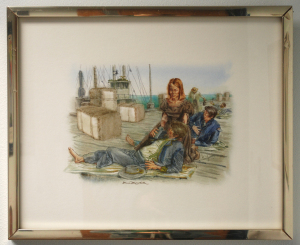This object is a framed original watercolor by Bruce Marshall entitled “Rosanna Osterman in Galveston, 1862.” Rosanna Osterman was a Jewish resident of Texas known for her work as a nurse during the Civil War. She was born in Germany in 1809 and moved to Maryland as a child. She married Amsterdam native Joseph Osterman, a silversmith and merchant who established a mercantile business in Galveston in 1838. Rosanna joined him in Galveston in 1839. When the town was overrun by a yellow fever epidemic in 1853, Rosanna operated a makeshift hospital on her family’s property to help care for the sick. As more epidemics swept through Galveston, evidence suggests she continued to volunteer as a nurse during these outbreaks. In 1862 the Civil War came to Galveston and the widow Rosanna again opened her home as a hospital, this time to both Union and Confederate soldiers. When citizens started to flee the city, she continued to care for the sick and injured. In addition to her nursing duties, Rosanna carried military information for the confederate army. In recognition of her nursing services, the 8th Texas Infantry regiment published a letter praising her in the Galveston News. She died in February of 1866 in a steamboat explosion aboard the W.R. Carter.
Many women wanted to help during the Civil War but were initially discouraged from contributing on both the Union and Confederate sides. In the north, women had to deal with male colleagues who thought they didn’t belong. In the south, women were denied permission to work as nurses for fear the experience might expose them to the horrors of war. However, as the war progressed, both the Union and Confederate armies changed their policies. Two months after the war began, the United States Secretary of War Simon Cameron appointed Dorothea Dix as Superintendent of Women Nurses. Dorothea was in charge of organizing and staffing the military hospitals. She also established specific criteria for her contracted nurses which included: a minimum age of 30, the ability to pay their own way, 2 letters of recommendation, and sobriety. Dorothea discouraged single women from joining for fear of exposing them to strange men and the hostilities of war. In August of 1861 the United States Congress authorized the Surgeon General to employ female nurses and as compensation paid them about $12 a month, plus food rations. Several northern women operated as nurses under the U.S. Sanitary Commission. The following year (1862) the Confederate Congress passed a law allowing civilians to serve in military hospitals, including women.
When the Civil War began, there were no formal schools to train nurses. Volunteer nurses were largely inexperienced. Instead, they received their education on the job. Civil War nurses had a lot of responsibilities. Among them, nurses had to change bandages, tend wounds, dispense medicine, pass out supplies, write letters on behalf of soldiers, cook and serve meals, and wash the laundry. In the course of their duties, they risked exposure to communicable diseases in unsuitable conditions as well as exposure to the dangers of the battlefield. Makeshift hospitals were overrun with the wounded and dying. But many women continued to volunteer. About 3,300 women served as nurses for the Union Army from 1861-1865 The number of confederate nurses is unknown, but the number seems to be in the thousands.
The efforts of women during the Civil War transformed the profession. The war shifted the range of nursing from the home to the hospital. It was Clara Barton, a Civil War nurse veteran, who founded the American Red Cross in 1881. In 1868 the president of the American Medical Association, Samuel Gross advocated for the creation of an official nursing school. The first formal nursing school in Texas was founded in 1890 by John Sealy hospital in Galveston. Thanks to the men and women who volunteered as nurses during the Civil War, nursing has become an integral part of the health profession that we benefit from anytime we need medical attention.
